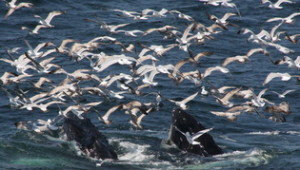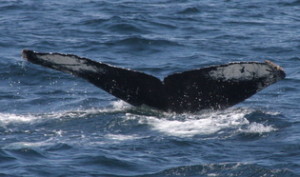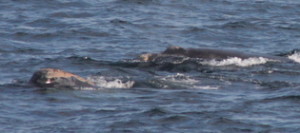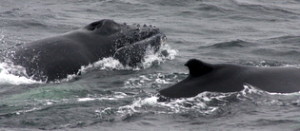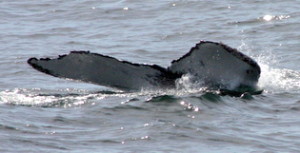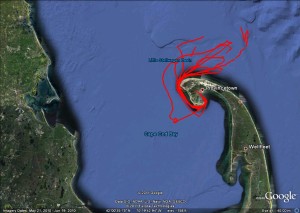Dolphin Fleet Naturalist Notebook – May 7 to May 13
May 7th looked like the best weather day to go out and watch for whales, so we squeezed in three trips and ended up seeing six species of whale over the course of the day! Fin whales, Atlantic white-sided dolphins, Humpbacks, and Right whale were all seen in the morning, while Minke whales and Sei whales made appearances on subsequent trips.
In the morning, we caught a quick glimpse of some feeding fin whales. While we usually associate bubbles with humpback feeding, every so often we’ll see a fin whale employing a similar tactic to corral prey, and today we got one good look at a fin whale lunging through a school of fish — quite a rare sight!
On each trip we counted seven different humpback whales. In the morning, we saw Onyx, Barb, Perseid, Hancock, and Centipede, who has been hanging around the Southern edge of Stellwagen Bank for the past few weeks.
Onyx
Like the fin whales, the humpbacks had found a big patch of food. Humpbacks and fin whales generally feed on similar prey items, such as small schooling fish, but humpbacks are much likely to feed in an obvious way, kicking and blowing bubbles and emerging with expanded, full mouths. Large flocks of birds often target the fish that are driven to the surface during these feeding bouts.
We continued to see humpbacks, fin whales, Minkes and dolphins into the afternoon. A few new humpbacks, including Pixar, had moved into the area to join the feeding frenzy.
Onyx
Even though most of the right whales have left the Bay and have moved on to more productive waters in the Great South Channel, we did have one lingering mother and calf on the afternoon trip. This year 21 right whale calves were born. Generally, rigorous survey effort in their calving grounds off the coast of South Carolina, Georgia and Florida, is able to document all of the calves born in a year, but this year, one mom and calf pair wasn’t counted until the late spring, when it was first seen by the Northeast Fisheries Science Center doing an aerial survey of Rhode Island Sound.
Right whale mother and calf
The weather deteriorated over night and by May 8th the seas were rough and the waters surrounding Cape Cod were ensconced in dense fog. In spite of the less than perfect weather, we did find a mother and calf that hadn’t been seen yet this year. In fact, we couldn’t even find it in the identification catalog at all! The rough seas had energized the calf who was breaching repeatedly, as its mother was lunge feeding. Leaping alongside the mother and calf pair was a small group of Atlantic white-sided dolphins.
The afternoon trip was not much better, weather wise, and we had to angle towards the west to shield ourselves from the wind. Fortunately, we did have a great look at a fin whale near Race Point, as well as two more in the bay. These large whales are nick-named “Razorbacks”, and from their long, narrow back you can probably see why! Despite their sometimes diminutive appearance at the surface, they are actually the second largest animal on the planet. They only seem small because we often only get a look at about a third of their bodies!
The seas churned and wind blew throughout the week and we weren’t able to get out again until Friday, May 13. The seas were still rather rough, which prevented us from getting too far out. As we bumped along looking for the first whale, the captain and naturalist spotted a sign of better weather to come — the first Wilson’s storm petrel of the season! Wilson’s storm petrels are small, migratory pelagic birds who flock to Stellwagen Bank by the thousands in the summer to feed on tiny crustaceans.
Both morning trips were able to get a good look at a North Atlantic right whale. Remember, we are not allowed to approach these whales within 500 yards, but this emerged not too far away from the boat and we were able to get a quick glimpse as we slowly created a distance between the boat and the whale. The right whale was booking it to the northeast, but we were able to see that it had massive entanglement scars across its head and back.
Right whales, like other large whales in the Gulf of Maine are at high risk of entanglement in fishing gear. Entanglements can range from mild to lethal, and are a leading cause of death for our already critically-endangered right whales. Notice the mouth scar on this animal. This type of entanglement can be particularly lethal as it can prevent the animal from feeding properly. The disentanglement team at the Provincetown Center for Coastal Studies has successfully disentangled over ninety large whales over the course of the program and should be contacted immediately if an entanglement is observed. To learn more about their program, visit their website.
The afternoon brought us to 2 humpbacks on long dives, fairly close to one another. Long dives can indicate that the whales are looking for food or finding food closer to the bottom. Fish concentrations can move up and down in the water column throughout the day depending on tides and light levels, and that can affect how often the whales surface, by extension. Both whales were both relatively small and thought to be juveniles. Towards the end of our time with them, one of them started bubble feeding! A great pay-off for our cold passengers!
Here’s where we went this week:








